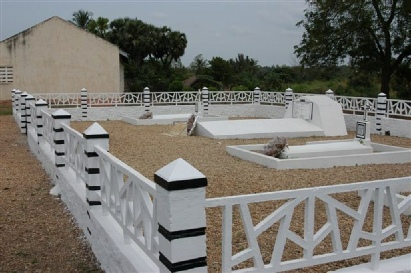



The Parish Church of St George the Martyr, Waterlooville

He was actually born in Eshowi Zululand on 21 February 1890, where his father Colonel George William Thompson was commanding a Royal Scots battalion. He was educated at Wellington College and then at Sandhurst where he represented the College at fencing. In October 1909 he was commissioned into the 2 Royal Scots based in Edinburgh. From 1910-
When war was declared a decision was quickly made to invade the neighbouring colony of Togoland in conjunction with French forces. The main aim was to capture an important wireless station at Kamina some 100 miles inland. The small force sailed from Accra and landed unopposed at Lome. George Thompson, because he spoke French, was placed in command of a small mixed force comprising 25 Gold Coast men and 17 Senegalese. After a week marching largely unopposed through the bush the column reached a strong German defensive position at Chera where some 100 German askaris were entrenched supported by 4 Maxim guns. The position was assaulted in August 22 but was halted by machine gun fire. Thompson and his men lay in the bush for 5 hours. Then, following a brief bombardment, Thompson ordered his men to make a bayonet charge. Unfortunately the Maxim guns had not been destroyed and Thompson fell mortally wounded 50 yards short of the German positions. Most of the African soldiers were also killed and their bodies were later found alongside Thompson’s body. That night the German commander fearing encirclement from another column ordered a retreat and Kamina was captured. Thompson was buried in Wahala cemetery close to where he fell and is the only British grave in the cemetery.
The French commander on 20 October published an Army Order commending the gallantry of Thompson and the fine example he gave to the French soldiers under his command and awarding him the Croix de Guerre with Palms. His father had retired to Burley and after the war placed a fine brass memorial to his son in Burley church. Most unusually his Gold Coast sergeant is named on the memorial and tribute also is given to the Senegalese tirailleurs killed that day.
TO THE GLORY OF GOD AND DEAR MEMORY OF GEORGE MASTERMAN THOMPSON LIEUTENANT THE ROYAL SCOTS THE SON OF COLONEL G W THOMPSON THE ROYAL SCOTS AND MRS THOMPSON, BEECHWOOD, BURLEY, BORN AT ESHOWE ZUL LAND "1ST FEBRUARY 1890 KILLED WHILE SERVING WITH THE WEST AFRICAN FRONTIER FORCE GALANTLY LEADING AN ATTACK ON A STRONGLY ENTRENCHED POSITION AT CHERA TOGOLAND 22 AUGUST 1914. “LOYAL TO THE KING, HIS COUNTRY AND HIS GOD” “IN A SHORT TIME HE FULFILLED A LONG TIME” IN HONOUR ALSO OF SERGEANT ASURI MOSHI AND A PRIVATE OF THE GOLD COAST REGIMENT, A SERGEANT, 2 CORPORALS AND 9 TIRAILLEURS (SENEGALESE) WHO BRAVELY FOLLOWED THEIR YOUNG LEADER AND LAID DOWN THEIR LIVES IN DEFENCE OF HIS BODY.
Lt Thompson is commemorated on the Burley War Memorial and also on the War Memorial at Kumasi Ghana, Wellington College, the R.M.C. Sandhurst memorial and the Royal Scots memorial Edinburgh Castle. The Scots claim him to be the first Scotsman to be killed in the war and a small exhibition of his effects plus Memorial Plaque was recently displayed at the Scottish National Memorial in Edinburgh Castle. This claim is certainly true regarding the army but a number of Royal Navy men were killed before August 22 and some of them may well be Scotsmen.
John Symonds
Autumn Edition 2014
George Masterman Thompson Memorial, Burley
There have recently been many commemorations relating to the centenary of the outbreak of the First World War. It has been stated that a Pte Parr was the first British soldier to be killed on August 23 1914 at the Battle of Mons. This in fact is not correct as a British officer Lt George Thompson was killed in action the previous day in faraway Togoland and an interesting and impressive memorial to him can be seen in Burley Parish Church in the New Forest.
He was actually born in Eshowi Zululand on 21 February 1890, where his father Colonel George William Thompson was commanding a Royal Scots battalion. He was educated at Wellington College and then at Sandhurst where he represented the College at fencing. In October 1909 he was commissioned into the 2 Royal Scots based in Edinburgh. From 1910-
There have recently been many commemorations relating to the centenary of the outbreak of the First World War. It has been stated that a Pte Parr was the first British soldier to be killed on August 23 1914 at the Battle of Mons. This in fact is not correct as a British officer Lt George Thompson was killed in action the previous day in faraway Togoland and an interesting and impressive memorial to him can be seen in Burley Parish Church in the New Forest.


War Grave at Wahala Cemetery